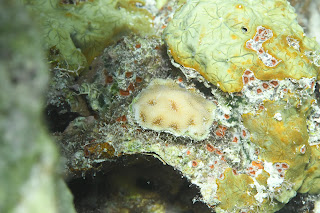Satisfied: part 3
"There's a million things I haven't done, but just you wait"
- "Satisfied" from the musical Hamilton by Lin-Manuel Miranda
It started in 2018. I put some tiles down on coral reefs to collect new recruits, and I got a few. Not a ton. It was the first time I had conducted research on reef-building corals, and I was surprised by how few individuals I caught.
 |
| One of the recruits in our quantitative dataset. |
Then it became an obsession. Where are all the baby corals, and why can't I catch many of them? I dispensed with tiles and checked for recruits on coral rubble, their natural habitat. It kind of worked. Then I dispensed with collecting samples and just started taking photos of baby corals wherever I found them. That worked really well. We collected hundreds of photos and really captured the diversity of recruitment on the reef. But there was a problem: the dataset was not quantitative. It was just a bunch of photos, not collected in any systematic, measured way.
We have data. In fact, we have a lot of data. But we need quantitative data. So we're taking a different strategy - again.
This year, we're doing quantitative recruit hunts. Every time we go out to a study site with our cameras, we also take transect tapes and meter-long PVC sticks. We measure out a 10 m transect on the reef and then search within 1 m of the transect tape. That way, we know exactly how many juveniles there are in a 10 square meter area. We collect photos of the adult corals over the exact same area so we can do a one-for-one comparison.
 |
| A cool-looking recruit with an adult Fungia coral on the left. |
Ultimately, I think we'll end up using both datasets. Maikani did a fantastic job of identifying all the corals in the descriptive dataset during her internship at WHOI, and she can identify the corals in the quantitative dataset too. Then we'll publish both side-by-side.
It's taken 5 years, but we have tons of data on coral recruitment. I am beginning to feel satisfied.
Comments
Post a Comment